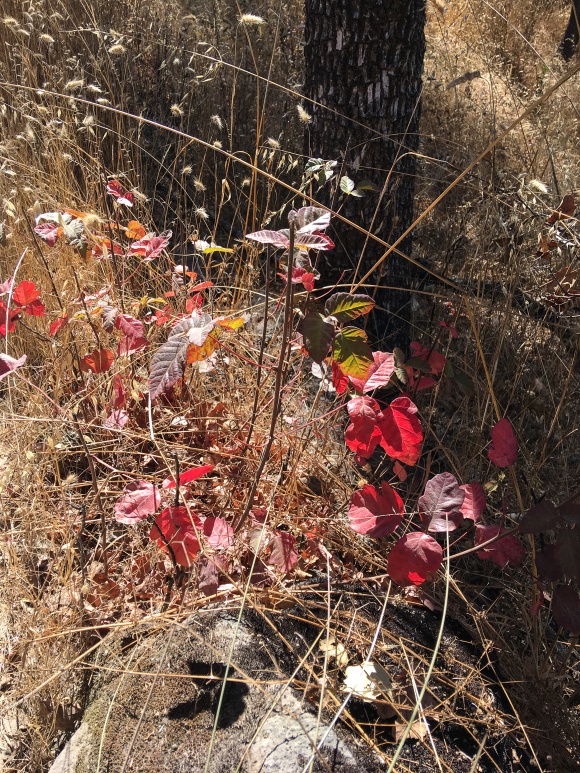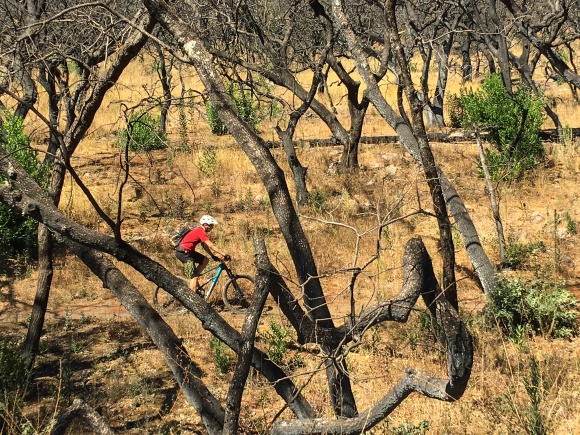As it passes through its thirtieth birthday, the team at Marin Bikes strikes the perfect balance between a modern bike company and keeping the dirt faith
“That’s poison ivy,” says my guide. “Don’t touch it, or else in three days you’ll know about it.” Three days? What kind of weird plant is that?

Of course, there’s all sorts of stuff that’ll make you itchy here at home, but the poison ivy in question – a beautifully beguiling mix of orange and red bush – lurks uncomfortably close to the side of these Californian trails.
The trails in question are a true mix of mountain biking’s most fun tests; janky rock chutes, winding, flowing runs on hardpack, softy, blown-out loam skirting long drops and powder-dry wide-open terrain, all winding through countryside that switches between completely desert-sky exposed to Alice-in-Wonderland spooky to the silent, soft and simply awe-inspiring cathedral of California’s magnificent redwood forests.
The Trione-Annadel State Park, about an hour north of San Francisco, was on the fringes of the 2017 Californian wildfires that destroyed a shocking 7500 homes in the north of the state… and some areas hadn’t escaped, as evidenced by the building works around the place.
Lush green bush contrasts markedly with blackened and scorched timber… I might be 12,000km from home, but nature has a funny way of bonding us all.

I’m out here today with Chris Holmes, the brand directorfor small but significant US bike company, Marin Bikes, who’s kindly invited me out to sample the park’s trails that are not far from Marin’s new facility in Petaluma (“The birthplace of the chicken incubator!” Chris tells me).
I’d arrived a tad late – those who know me will not be surprised in the least – and even though there are no signs on the building’s exterior, it’s not hard to find. Acollection of biker’s cars outside – Subarus, VW vans with racks and the like – is a giveaway.
A tall bloke by the door is washing down a Wolf Ridge, and he directs me inside. Turns out he’s Steve ‘Gravy’ Gravenites, one of the most well-known mechanics on the 1990s World Cup circuit, and he’s washing the bike I’m using today.
Inside, the building is randomly peppered with bikes; a hybrid style bike here, a dusty evaluation hardtail over there.
Energy bars and gels reside next to the coffee machine in the break room, and the shower room is festooned with bike apparel in various states of age and cleanliness.
Gravy’s workshop is sizable and well equipped, while a visual history of the brand adorns the wall next to the conference hall. There’s a titanium Marin FS frame that uses Manitou 3, for example, along with other signposts of a mountain bike legacy that stretches back to the early 1990s.
Marin doesn’t actually make anything locally in the States – they share factory space with Polygon in a facility in Indonesia – but there are 15 people within the US office that work on product development, sales, marketing and other back-office functions.
Gravy and I discuss the merits of sizing me up on an XL frame, and I take his advice… only to find that my 110kg is right on the top threshold of the suspension window. So light is the compression tune on the unusual-looking Wolf Ridge, it really brings spring rate to the fore. We set it up at the top of the curve despite Gravy sucking air in through his teeth, I gather my stuff, and we head out in Chris’s VW van.
The company’s old headquarters in nearby Novato served as home for more than a decade, and were made infamous by the fact that seminal 1980s acid rock band The Grateful Dead used to use the space as a rehearsal studio. “We kinda grew out of that place a bit,” said Chris, wrinkling his nose a little. “Our new place has a lot more room.” He adds that they’re now in the same complex as Camelbak and E-Thirteen, so there’s a real industry connection.
En route, Chris tells me that Marin used to use the state park for testing, but they’ve since moved it out to Arizona, under the watchful eye of industry doyen Joe Murray
“Annadel isn’t really the best place to do a test of Wolf Ridge suspension, so we did a lot of that testing in Sedona, Arizona,” he says. “They have some pretty amazing trails, the climate was right of the time of year we were testing it, and Joe, who we used as a development consultant, lives in Flagstaff, so it’s pretty easy for him to get to.
“The amazing thing is, his first job [in the cycling industry] as a product manager was with Marin.”
The company is 30 years old, and has been through a few iterations in that time. It’s now owned by an investment group, and it’s run by industry veteran Matt Van Enkevort, who we say a quick hello to on the way through the building.
“Matt’s built up a really good team, and it’s taken a while to rebuild the brand,” says Chris. “He thought it was gonna take like three years, but in reality it took five for it to really be back on our feet again, and now we’re finally firing on all cylinders.”
Matt had told me in passing he’d actually done a cycling tour of Australia in his youth, but Chris, grinning, filled in a particularly amusing blank.
“Part of the story that he didn’t mention was about going into a bar in country Queensland,” Chris laughs. “He walks in, looked around, and he’s like a scrawny, cycling guy, so he’s like, “Oh shit, I need to make friends.” He walks to the bar and says ‘Hi. My name’s Matt. I’m from Alaska. I’m buying everyone a beer.’”
The Marin brand was reintroduced into Australia last year, and Chris confirmed that even though bikes like the Wolf Ridge and the Polygon XquareOne look identical, there’s a degree of separation between the two.
“Our bikes are made in the same factory that Polygon bikes are made in, but we are separate companies,” confirms Chris. “We have no affiliation with them. Polygon is a separate brand altogether.”

He says it’s an advantage, though, for both companies to be building the unusually configured Naild-equipped bikes in the same facility, though, when it comes to tooling and final assembly.
By this time, we’ve arrived at our destination, and we’re pedalling up a longish road climb to get to the trail head. While I pant, Chris talks about the company’s 30thanniversary in 2016.
“We brought back some heritage names and some models that have been kind of dormant for a while,” he says. “We brought back these classic names but in a more modern format, like the Pine Mountain as a 27.5-Plus bike. We brought back some very cool heritage inspired colours and graphics with it, colour matchingthe stem and the fork together like something Marin did some 25-30 years ago.”

We bomb into the first section of the trail, which is wide open and, in my mind, quite ‘Californian’ in its style; wide, smooth and fast. I’ve tested the Wolf Ridge before, but it’s always cool to ride a bike close to where it was conceived.
It certainly doesn’t feel like a 160mm 29er. Chris mentions that the idea had been kicking around for some years before Marin committed to the notion of a long-travel 29er trail bike; while it feels about right now, it would have sounded like madness even five years ago to suggest such a bike could be viable.
“We have ideas of what to do with that platform on down the line,” he says. “But we launched with the Wolf Ridge in a 29-inch wheel 160mm travel format knowing that that was the bike that could speak to the need of the market.”
He reckons it’s been designed to offer that elusive ‘one bike fits all’ conundrum.
“Yeah, I’m guilty of a lot of other bike industry dorks by having a garage full of bikes, but I only have one full-suspension mountain bike and that’s the Wolf Ridge,” he says. “It’s not World Cup XC light, but I did a 35-mile (50km) cross country race on it a few weekends back, and it was awesome.”

The terrain’s been ratcheting up and up, and it’s changed from wide vistas and long turns to wooded bush and rocky, tight sections that really should see the Wolf Ridge on the back foot… but it doesn’t flinch.
Again, like a scene change in a movie, we roll down and through a valley that’s simply dominated by the majesty of old-growth redwood. It’s silent, still and serene, as we flow with ever-increasing pace through the dappled light to the bottom of another climb. Whaka Forest in New Zealand is great, but this… is just next level.

All too soon, we’ve looped back around to the end of the trail, popping back out into Californian plains and negotiating one last rock-strewn double-trail pass on the way back to the car and a well-earned feed at Lepe’sTaqueria in nearby Santa Rosa.
Chris and I shoot the breeze over sizable chicken burritos, I ask him why Aussue should be looking at Marin as a potential place for their next bike. “First and foremost, we’re setting out to make world-class bikes for riders of all levels and all types, so these world-classbikes can be ridden in places like Australia, or Santa Rosa, or the UK or Israel, whatever. But I mean that the first, the most important thing for us was to get make sure that the product’s right. It makes my job in marketing a lot easier, too – I don’t need to put lipstick on the proverbial pig here.

“It comes to point where we partner with our distributionpartners down under, to get the message out about what the bikes are about, who they’re for, what we bring to the table, and I think once the consumers are aware of it and get the experience we’re in, they‘ll understand what we’re about.”
If the office loop ride and the culture of this small, vibrant company with more than 30 years in the game is anything to go by, then the brand is a good fit already.






